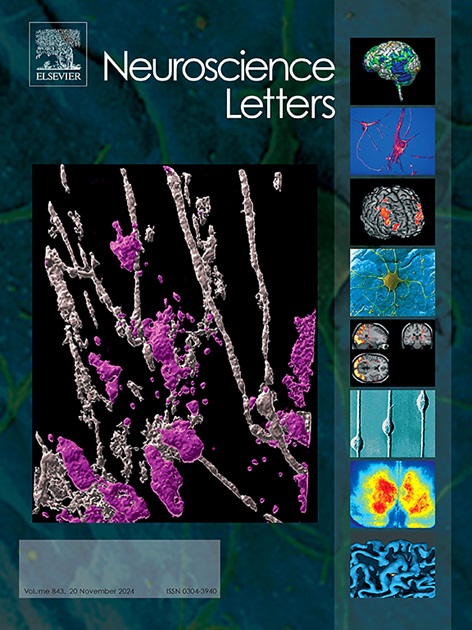老年人面部识别的神经代偿性变化:来自事件相关电位诱发和振荡反应的证据。
IF 2.5
4区 医学
Q3 NEUROSCIENCES
引用次数: 0
摘要
虽然人脸识别是人类社会交往的基本功能,但人脸识别、记忆保持和处理速度随着年龄的增长而下降。最近的事件相关电位研究表明,衰老效应发生在相对较早的感知阶段;已经注意到N170成分的振幅和潜伏期与年龄相关的增加和半球侧化的减少。然而,对P100成分的研究很少,结果也不一致。在这里,我们测量了年轻人(n = 22)和老年人(n = 22)在面部刺激呈现时的事件相关电位。我们重点研究了与刺激相锁定的神经元瞬态(P100和N170),从而反映了神经元输入的变化。我们还分析了P100和N170的振荡活动,其潜伏期随试验而波动;这标志着每个试验的耦合机制。我们观察到P100和N170的显著年龄相关差异。值得注意的是,老年人没有表现出年轻人对保留的面部反转效应的典型右半球优势。期间一致性分析显示,老年人的期同步性低于年轻人。我们的研究结果表明,初级视觉皮层中与年龄相关的功能变化会影响P100成分,并且N170在右半球中的优势性降低可能归因于神经代偿。因此,面部识别的神经特异性似乎在老年人中保留下来,抵消了衰老效应。此外,试验间相位相干测量表明,与年龄相关的面部识别能力下降可能是由面部特定区域的异步锁相神经活动来解释的。本文章由计算机程序翻译,如有差异,请以英文原文为准。
Neuro-compensatory changes in face recognition in older adults: evidence from evoked and oscillatory responses of event-related potentials
Although face recognition is an essential function for human social interaction, face identification, memory retention, and processing speed decline with age. Recent event-related potential studies suggest that aging effects occur at relatively early perceptual stages; age-related increases in amplitude and latency and reduced hemispheric lateralization of the N170 component have been noted. However, studies into the P100 component have been sparse and yielded inconsistent findings. Here, we measured event-related potentials during face stimulus presentation in young (n = 22) and older (n = 22) adults. We focused on neuronal transients (P100 and N170) that are phase-locked to the stimulus, thereby reflecting changes in neuronal input. We also analyzed the oscillatory activities of P100 and N170, whose latencies fluctuate from trial to trial; this signaled the coupling mechanisms of each trial. We observed significant age-related differences in both P100 and N170. Notably, although older adults did not exhibit the characteristic right hemispheric predominance observed in young adults, they still demonstrated the preserved face inversion effect. Intertrial phase coherence analysis revealed lower phase synchronization in the older adults than in the young adults. Our findings suggest that age-related functional changes in the primary visual cortex influence the P100 component, and that the reduced right hemispheric predominance of N170 may be attributed to neural compensation. Thus, neural specificity for face recognition appears to be preserved in older adults, counterbalancing the aging effect. Moreover, intertrial phase coherence measurements indicate that the age-related decline in face recognition may be explained by asynchronous phase-locking neural activity in the face-specific area.
求助全文
通过发布文献求助,成功后即可免费获取论文全文。
去求助
来源期刊

Neuroscience Letters
医学-神经科学
CiteScore
5.20
自引率
0.00%
发文量
408
审稿时长
50 days
期刊介绍:
Neuroscience Letters is devoted to the rapid publication of short, high-quality papers of interest to the broad community of neuroscientists. Only papers which will make a significant addition to the literature in the field will be published. Papers in all areas of neuroscience - molecular, cellular, developmental, systems, behavioral and cognitive, as well as computational - will be considered for publication. Submission of laboratory investigations that shed light on disease mechanisms is encouraged. Special Issues, edited by Guest Editors to cover new and rapidly-moving areas, will include invited mini-reviews. Occasional mini-reviews in especially timely areas will be considered for publication, without invitation, outside of Special Issues; these un-solicited mini-reviews can be submitted without invitation but must be of very high quality. Clinical studies will also be published if they provide new information about organization or actions of the nervous system, or provide new insights into the neurobiology of disease. NSL does not publish case reports.
 求助内容:
求助内容: 应助结果提醒方式:
应助结果提醒方式:


